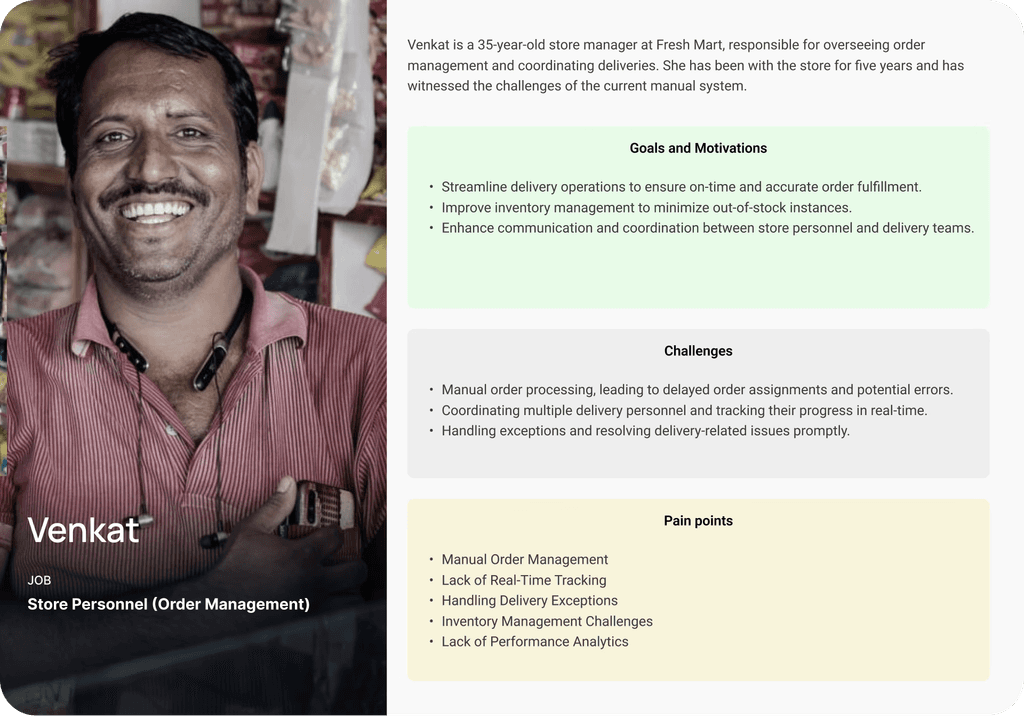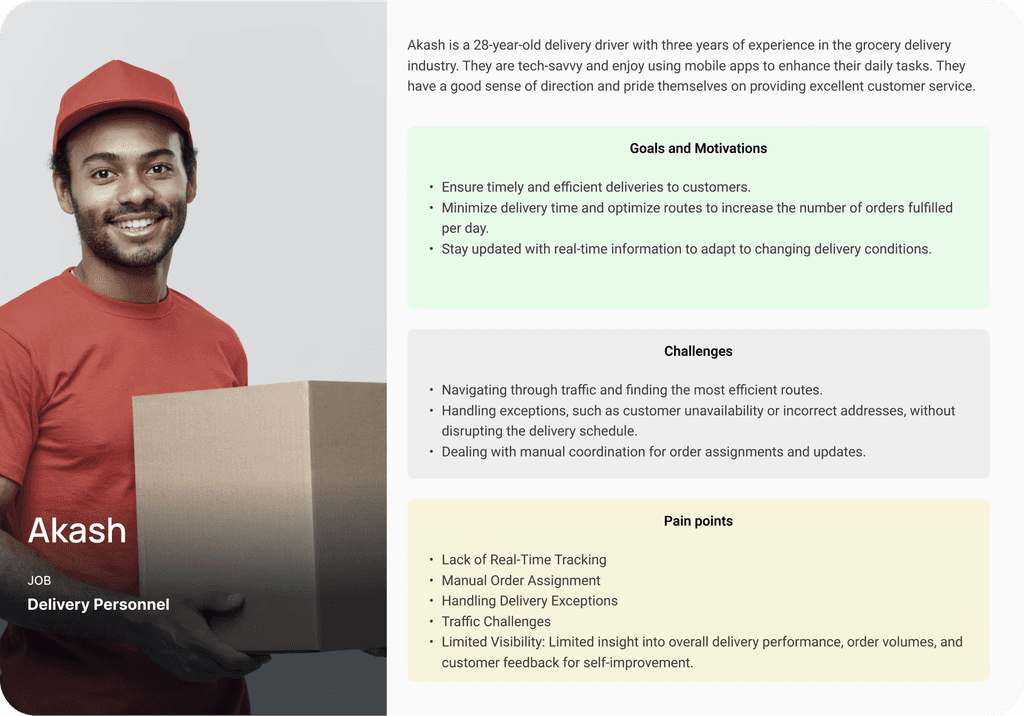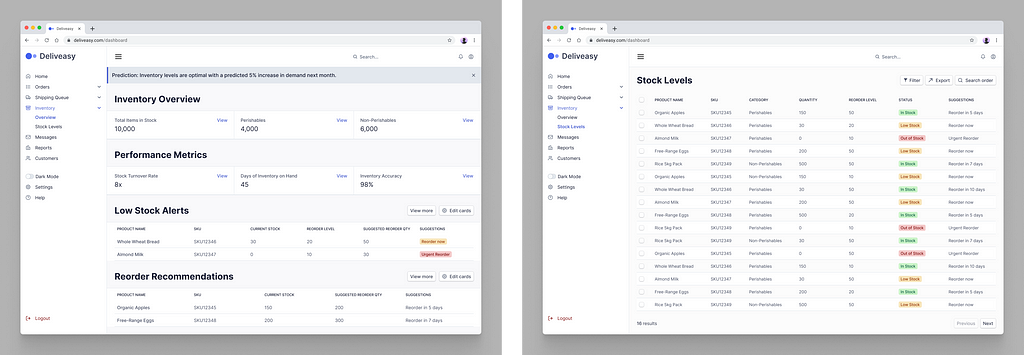Deliveasy enhances delivery efficiency and customer satisfaction for Indian supermarkets with real-time tracking, route optimization, and detailed analytics.

Context
The e-grocery market in India, Indonesia, and MENA has experienced significant growth, driven by pandemic-induced demand. From 2019 to 2022, MENA and Indonesia saw over 100% CAGR, while India had a 66% CAGR. This trend is likely to continue due to the convenience and safety of online grocery shopping.
The Challenge
Supermarkets in India face significant delivery challenges, including late deliveries, inefficient routes, and customer dissatisfaction. The goal was to develop a modern solution to address these issues.

Problem Statement
Supermarkets struggle with manual delivery management systems. They lack real-time tracking, efficient route planning, and streamlined communication, leading to delays, customer complaints, and operational inefficiencies. A modern, automated solution is needed to transform delivery processes and improve customer experience.
How Might We
- How might we provide real-time tracking to ensure punctual deliveries?
- How might we optimize delivery routes to reduce travel time and costs with lesser team size?
- How might we streamline communication to improve customer satisfaction?
- How might we integrate seamlessly with existing supermarket systems?
- How might we cater specifically to the unique needs of the Indian market?
- How might we leverage analytics to gain insights into delivery performance and operational efficiency?
Success Metrics and Business Goals
Business Goals
- Increase Operational Efficiency: Streamline delivery processes to reduce delivery times and operational costs.
- Enhance Customer Satisfaction: Improve customer experience through timely deliveries and real-time updates.
- Market Penetration: Expand Deliveasy’s adoption among supermarkets across India.
- Revenue Growth: Boost revenue by increasing the number of supermarkets using Deliveasy and improving delivery efficiency.
Success Metrics
- Delivery Time Reduction: Aim for a decrease in average delivery times.
- Operational Cost Savings: Target a reduction in fuel and delivery-related expenses.
- Customer Satisfaction Improvement: Achieve an increase in customer satisfaction ratings.
- Market Share Expansion: Increase the number of supermarkets using Deliveasy.
- Revenue Growth: Attain an increase in revenue from Deliveasy subscriptions and services.
Even though this is a conceptual case study, We set these success metrics and business goals to guide our efforts and measure the impact of Deliveasy on the supermarket delivery management landscape in India. This ensures that our design decisions align with our strategic objectives and deliver tangible benefits to our users.
Discovery
Competitive Analysis
I conducted a competitive analysis of both direct competitors, like ShipRocket, Onfleet, and FarEye, and indirect competitors, such as Zomato. This analysis involved evaluating their strengths, weaknesses, opportunities, and threats (SWOT). By understanding both direct and indirect competition, we identified Deliveasy’s unique value propositions and areas for strategic improvement to better serve the supermarket delivery management market in India.

Competitive analysis key findings
- Unique Market Focus: Deliveasy focuses on supermarkets, setting it apart from competitors targeting e-commerce or hyperlocal deliveries.
- Food Delivery Niche: Potential competition from food delivery platforms like Zomato.
- Seamless Integration: Deliveasy’s ability to integrate with supermarket systems provides a competitive edge.
- Localized Service: Tailored solutions for the Indian market ensure better understanding and service.
User Research
Interviews and feedback from store personnel, delivery staff, and customers identified key pain points and expectations, guiding feature development.
User Personas
- Store Personnel: Focus on managing inventory and ensuring timely deliveries.

- Delivery Personnel: Emphasis on receiving assignments, planning routes, and delivering items efficiently.

User Journey Mapping
- Venkat’s Journey: Venkat starts her shopping journey by creating a shopping list and exploring various local grocery stores. She visits the chosen store, picks the items, and proceeds to the checkout, after which she schedules the delivery and awaits its timely arrival.

- Akash’s User Journey: Akash, as a delivery personnel, receives delivery assignments on his mobile app, plans the optimized route, picks up the items from the store, and delivers them to the customers’ addresses while ensuring prompt and friendly service.

Feature Priority Analysis
High Priority
- Real-Time Tracking: Ensures punctual deliveries and enhances customer satisfaction.
- Route Optimization: Reduces travel time and fuel costs, increasing operational efficiency.
- Inventory Management (Low Stock Alerts and Reorder Recommendations): Prevents stockouts and ensures timely restocking, maintaining smooth operations.
- Order Management (Overview and Detailed Table): Provides comprehensive visibility into order status and performance, aiding in efficient management.
- Customer Notifications: Keeps customers informed about delivery status, improving their experience and satisfaction.
Medium Priority
- Reports Overview with Graphs: Offers visual insights into delivery performance and trends, aiding strategic decisions.
- Driver Performance Metrics: Monitors delivery personnel performance, ensuring accountability and efficiency.
- Daily, Weekly, and Monthly Sales Reports: Provide detailed insights into sales trends and performance over different time frames.
Low Priority
- Heatmap of Top-Ordered Areas: Visualizes high-demand areas, aiding in strategic planning but not critical for initial functionality.
- Detailed Stock Levels Table: Offers granular visibility into stock status, useful but secondary to immediate operational needs.
This prioritized feature list ensures that the most critical functionalities are developed first, providing the most significant impact on operational efficiency and customer satisfaction for Deliveasy.
The Solution
Deliveasy was conceptualized to revolutionize delivery management for supermarkets by offering:
1. Dashboard Page
- Key Metrics Display: Shows total orders, units ordered, total amount, and shipments delivered. This provides a quick overview of performance, derived from user feedback on the need for quick access to essential data.
- Reports Overview with Graphs: Visual representation of revenue, shipment sales, delivery issues, and more. Added based on research showing that visual data helps in better decision-making.
- Real-time Stats Notifications: Alerts for order placements, shipment delays, and customer messages to keep users informed instantly, addressing the need for prompt updates.
- Delivery Trends Visualization: Displays shipment volume trends, aiding in understanding peak times and optimizing delivery schedules.
- Heatmap of Top-Ordered Areas: Highlights high-demand regions to assist in strategic planning and resource allocation.


2. Order Summary Page
- Overview of Orders: Displays total, pending, completed, and canceled orders, providing a comprehensive status at a glance.
- Revenue Summary: Shows revenue and percentage change, helping in tracking financial performance.
- Quick Stats: Includes average order value, customer satisfaction, and top-selling products, offering insights into sales performance and customer preferences.


3. Shipping Pages
- Shipment Summary: Overview of total deliveries, on-time deliveries, delivery success rate, and delivery distance covered. This comprehensive view ensures transparency and accountability in the delivery process.
- Driver Performance Metrics: Monitors driver performance, ensuring high service standards and addressing the need for performance tracking.
- Real-Time Tracking: Live map showing the location of deliveries and drivers, enhancing transparency and customer satisfaction.
- Shipping History: Detailed list of shipment history with order and delivery details, aiding in performance tracking and issue resolution.
- Shipping Queue Management: Interface for managing current, upcoming, and delayed shipments, allowing efficient resource allocation and addressing the need for streamlined operations.


4. Inventory Overview
- Total Items in Stock: Provides a summary of all items available, helping to maintain optimal stock levels.
- Performance Metrics: Includes stock turnover rate and inventory accuracy to monitor efficiency and reduce wastage.
- Low Stock Alerts: Alerts for items nearing depletion, ensuring timely restocking.
- Reorder Recommendations: Suggests reorder quantities based on past data, aiding in inventory management.
- Detailed Table of Stock Levels: Shows product name, SKU, category, quantity, reorder level, status, and reorder suggestions.

5. Sales Reports Page
- Daily, Weekly, and Monthly Sales Reports: Offers detailed insights into sales trends over different periods, aiding in performance analysis and strategic planning.
- Product Performance Trends: Highlights sales and unit sold trends for individual products, helping identify top-performing items.

6. Messages Screen
This screen facilitates real-time communication between delivery managers and drivers, essential for managing delivery statuses, delays, and issues promptly. Based on user feedback, it addresses the need for clear, direct communication to avoid delivery mishaps.

Results
Supermarkets might experience:
- Reduced Delivery Times: Efficient route planning and real-time tracking.
- Lower Operational Costs: Optimized routes reduced fuel consumption.
- Improved Customer Satisfaction: Timely deliveries and proactive communication.
- Enhanced Efficiency: Streamlined operations and actionable insights from analytics.
Case Example
SuperMart’s Success with Deliveasy
- Initial Challenges: Inconsistent delivery times, high fuel costs, and frequent customer complaints.
- Implementation Process: Integrated Deliveasy within two weeks, provided thorough staff training.
- Positive Impact: 30% reduction in delivery times, 20% decrease in fuel costs, 50% increase in customer satisfaction.
Conclusion
Deliveasy is a transformative solution for supermarkets in India, addressing key delivery challenges and driving significant improvements in efficiency and customer satisfaction. With features like real-time tracking, route optimization, and detailed analytics, Deliveasy sets the stage for the future of delivery management.
And that’s a wrap! Piqued your interest? Just holler!
Twitter | LinkedIn | Let’s Chat
Do follow me. I’m happy to connect on SM
Happy designing !!!
DelivEasy: Revolutionizing Supermarket Delivery Management in India was originally published in UX Planet on Medium, where people are continuing the conversation by highlighting and responding to this story.